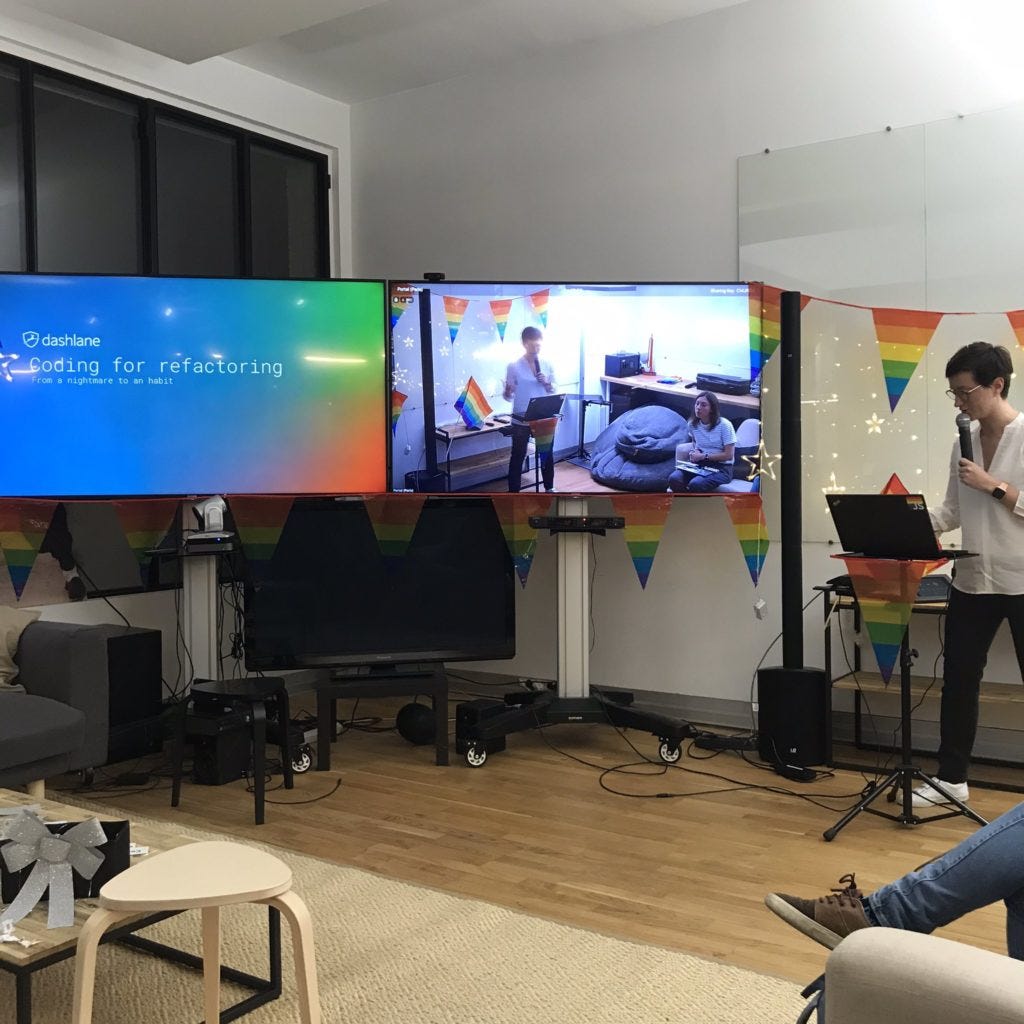I am a woman. I am a developer. I’ve been working in tech for 11 years. I started working as a developer in Italy, and after 6 years I moved to Paris to pursue my ambition of becoming a technical leader. Two years ago I had the opportunity to face the challenge I had been waiting for: I got offered a Tech Lead role at Dashlane.
At Dashlane, a Tech Lead coordinates technical tasks such as evaluating the feasibility, cost, and general architecture for the implementation of a feature. We coordinate technical communication across platforms and ensure junior developers are properly onboarded to technical projects.
As soon as I secured the title that I was aiming at, I started freaking out. It was my first time in this role, and I didn’t know where to start. I was named tech lead in a team where I had joined just 6 months before, with talented and more experienced people. Moreover, I was taking over the role from a colleague that was still part of the team.
My impostor syndrome flared up with a vengeance. And that led me to a series of mistakes and misconceptions over my role-mistakes that I believe made me a better tech lead today. These are few of the tips I would tell myself if I could turn back time.
I recently shared them during a webinar for 50inTech.
Trust your team

One of the skills that got me into this role was my vocality. I have always spoken up, stood up for my ideas, and pushed to reach the finish line.
My first mistake was to think that as a tech lead I was expected to keep pushing for my ideas*.* To be the expert in the room. To always come up with the best solution. My imposter syndrome played a big role in this misconception, whispering that I was not worthy to be in my role. And that made me try even harder to be the one with the best idea-always.
A mentor once told me I was a leader because I was a control freak. But once you become a leader, you need to let it go. Loosen your control. Listen and trust your team. And that put me out of my comfort zone.
I learned the lesson the hard way: one of my senior colleagues wanted to test a technology I didn’t like. He had to ping me for months before I finally let him work on a proof of concept. And it worked. I put both of us in an awkward situation and let him feel unheard. That taught me to listen more carefully to my team, and to always criticize my own ideas. In tech it’s hard to find a perfect solution, there are always pros and cons. Learning to find both strong and weak points is hard but will improve collaboration within your team. Showing the vulnerability in your thoughts is a way to ensure psychological safety and will let your less vocal team members feel comfortable with coming with alternatives. And that’s the way to the best solution.
Let your team fly
Second lesson, don’t be the explorer; encourage your team to explore. My first idea of my role was to run all the investigation, solve all the unknown, and prepare straightforward tasks for my team. As much as my Product Manager liked this, I was taking away all the fun of exploring the unknown from my team. Not all devs are comfortable with it, but if you have what Kim Scott in “Radical Candor” calls “superstars,” you have to share the fun with your team. It’s hard, but that is what a Tech Lead does. And throughout it all, you will still be there to learn with them during the research. Be there for your team, mentor them and explore with them. Stoking the passion is part of your role.
Be a filter

Third tip, keep your steam out of your team. Becoming a Tech Lead to me meant being a buffer between the inside and the outside of the team:
Communicating and dealing with stakeholders pressure will need your energy
A new developer joining the team, having a hard time onboarding and aligning with team rituals and habits will need your energy
That discussion on architectures will need your energy
Briefly, your energy will be consumed, and that will be a source of stress. Try not to expose your team to your stress; filter sources of pressure. Address your concerns and discuss transparently with stakeholders when you think processes can improve or when you are not aligned with plans. Giving constructive feedback to my managers is an exercise that put me out of my comfort zone, but that helped to build a strong relationship of trust. Taking care of yourself will help you have a consistent mood in front of your team. Do not hesitate to take breaks and speak up when you feel tired, and avoid closing your laptop violently during a meeting because you received a message on Slack you didn’t like-this will scare the team! And you need your team to feel safe and supported.
Learn to say no

Don’t take on every single job that is asked of you. When you lead by example working overtime to help the team complete their job, your example will be wrong. Take on boring tasks, and find out why there’s extra work to do, as there might be a process issue. Discuss with your agile coach, see how you can improve the flow, and take time for yourself. Leading by example means showing that you care for your team by caring for yourself. Your team needs to know that you’re ready to get your hands dirty, but that you respect personal time-starting with yours.
Reach out to communities

The most important thing to me is bringing passion and enthusiasm. To do that I go to conferences and participate to local meetups. I have never come back from a conference without new ideas to implement. At C++ Italia I found out about WinDbg Preview and time travel debugging — that became my first ever meetup talk and a blog post. At React Finland I first heard about design systems-and since then I pushed to implement one at Dashlane. Go to conferences, be a speaker, and encourage your team to do the same. Start from local meetups. It will be source of inspiration, because other speakers will bring their passion, too. I also recently found Twitter as a great source of tech news and awesome people. It’s thanks to Twitter that I discovered QueerJS, a wonderful community that I am now proudly a part of.
In conclusion
These are the lessons I learnt during my first steps as a tech lead. I love the mix of people and technical skills that it requires, and I’m grateful for the talented and thoughtful team that supported me during my learning on the field. The best of it is that I continuously learn from everyone. My impostor syndrome is still something I’m working on, but working for a company that encourages sharing vulnerability from the top down helps, as does being surrounded by inspiring women. WiMLDS, Ladies of Code, and QueerJS helped me meet wonderful people that share the same fight. And in this fight, unity is strength.
Did you find these tips useful? Do you have any other that helped you? Reach me on Twitter at @PolaDuco, I’ll be glad to share.
